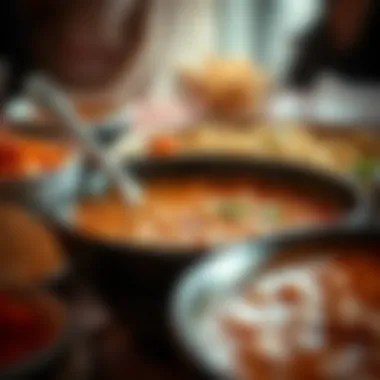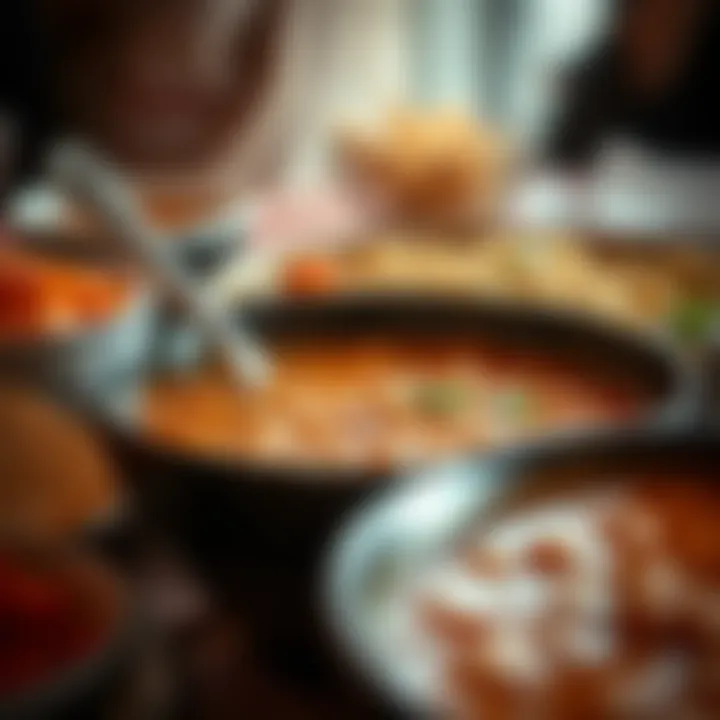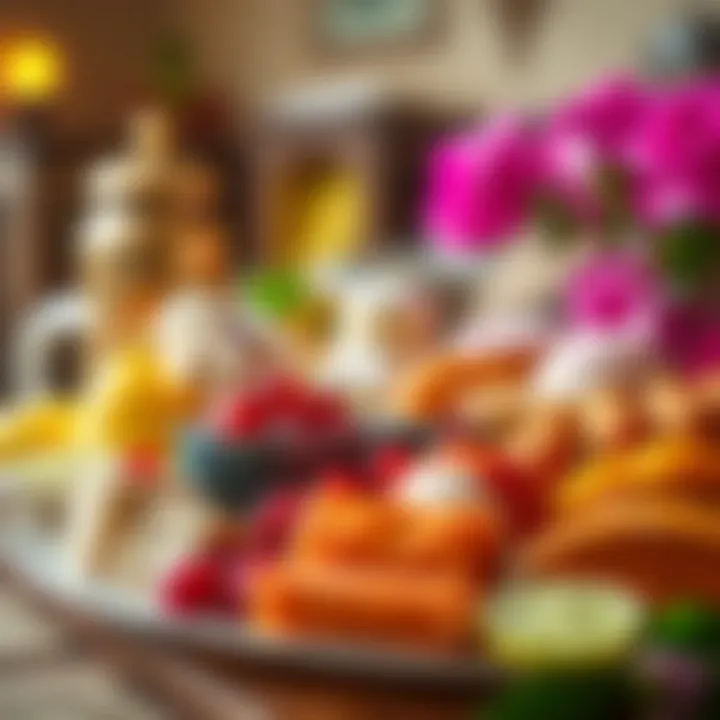Cultural Insights into Suhoor and Iftar Traditions


Intro
Ramadan is not just a month of fasting; it's a time steeped in rich traditions, vibrant community gatherings, and culinary delights that are as diverse as they are delicious. At the heart of this holy month are the meals of suhoor and iftar. These meals are more than mere sustenance; they serve as anchors in the daily rhythm of Ramadan, fostering a sense of togetherness and cultural identity.
Suhoor, the pre-dawn meal, is often characterized by its significance in providing the energy needed to sustain fasting until sunset. Families come together in the quiet of the early morning, indulging in dishes that range from simple bread and dates to hearty stews infused with spices. It’s a time for reflection and preparation, as participants not only fuel their bodies but also connect with loved ones.
Iftar, the meal that breaks the fast, offers an opportunity for communities to rally around traditional dishes, share stories, and strengthen bonds. With the call to prayer marking the end of the fast, fruits and sipping water often usher in the meal, followed by a spread of culinary treasures that reflect local traditions in Dubai and across the world.
Through this article, we aim to provide a comprehensive look into the cultural fabric woven by suhoor and iftar, examining the typical dishes, the values they embody, and their role in enhancing the spirit of community. This exploration will enhance your understanding of not just the meals themselves, but the social dynamics they encourage, making Ramadan a truly sacred time for many.
Prolusion to Suhoor and Iftar
In the realm of Ramadan, suhoor and iftar emerge as cornerstones that shape both the culinary landscape and cultural ethos of the month. These meals, the pre-dawn feast and the post-sunset banquet, serve as more than mere sustenance; they encapsulate the spirit of togetherness, devotion, and community. Understanding suhoor and iftar is essential for appreciating the rich tapestry of customs and practices within this holy month, particularly in vibrant locales such as Dubai.
Both meals bear significant weight in terms of dietary needs, spiritual reflections, and social engagements. For many, suhoor represents an essential boost of energy that sustains them through the daily fast, while iftar marks a time for joy and fellowship, reuniting families and communities as they break their fast together. This exploration into these two pivotal dining moments sheds light on their historical background, nutritional importance, and the diverse cultural expressions associated with them.
Here, we dive into the many layers surrounding these vital meals, examining how they connect with personal and communal identity, and illustrating their enduring role in shaping the fabric of society during Ramadan.
Understanding the Purpose
The purpose of suhoor and iftar extends well beyond the act of eating. During Ramadan, fasting cultivates self-discipline and empathy towards those less fortunate. Suhoor, often consumed in the quiet hours before dawn, is designed to equip individuals with necessary nutrients, thus fortifying their resolve for the day ahead. It emphasizes mindful consumption, as the choices made during this meal can significantly influence one’s energy levels and overall well-being during the long hours of fasting.
Conversely, iftar is imbued with a sense of communal joyousness. As the sun sets, families and friends gather to welcome the breaking of the fast, often doing so with the traditional date and a sip of water, symbolizing gratitude and refreshment. It's a moment steeped in tradition and reinforced by a deep sense of belonging, facilitating connections that span generations.
Historical Context
Tracing the roots of suhoor and iftar reveals a fascinating interplay of cultural evolution and religious significance. Historically, these meals have been influenced by regional customs, personal preferences, and the availability of ingredients. In ancient times, communities would often gather around a communal table, sharing their food in a spirit of unity, reflecting the transient nature of life, and the necessity of reliance on each other.
As trade routes expanded, so did the introduction of various culinary spices and methods, creating a rich patchwork of culinary practices associated with suhoor and iftar. For instance, in the Middle East, it is common to find dishes flavored with fragrant spices such as cumin and coriander, while Southeast Asia often embraces rich coconut flavors in its meals. This melding of flavors not only underlines the historical movement of peoples and goods but also provides insight into the adaptability of cultures in response to shared practices like Ramadan fasting.
"The heart of suhoor and iftar lies in their ability to weave threads of history, culture, and community into a dining experience that transcends the mere act of eating."
Thus, the significance of these meals takes on a multidimensional character, one that resonates deeply with a commitment to faith and an enduring bond with those around us.
The Significance of Suhoor
The pre-dawn meal of suhoor holds substantial importance during Ramadan, serving not only as a practical nutritional necessity but also as a cultural landmark. It's not just about filling the belly; it’s an experience embedded in faith, community, and tradition that transcends simple culinary practice. This meal offers Muslims, especially those residing in cities like Dubai, a chance to prepare physically and spiritually for the day ahead of fasting.
Nutrition for Fasting
Nutrition during suhoor is pivotal. A well-balanced meal can set the tone for the entire day's fasting. Foods rich in complex carbohydrates and proteins, such as oats, eggs, or yogurt, are options many choose to sustain their energy levels throughout the day. Eating foods with higher water content, like fruits—think watermelons or cucumbers—can also help maintain hydration, as they are helpful for those long hours without water.
In many households, suhoor isn’t just a solitary affair; often, families gather around the table to share this first meal. This shared experience can create an environment of love and unity, reinforcing familial bonds as they prepare to embark on the spiritual journey of Ramadan together.
Cultural Variations
The customs surrounding suhoor may vary widely across the globe, reflecting diverse culinary traditions and local customs. In Southeast Asia, for example, it’s common to indulge in hearty dishes like nasi lemak, which combines rice cooked in coconut milk along with savory accompaniments such as fried anchovies and peanuts. On the other hand, in middle eastern cultures, invitations for suhoor often lead to communal meals that feature dishes like foul medames or shakshouka, tantalizing dishes that have become favorites in homes throughout the region.
These variations extend beyond just food; they encompass the very way the meal is presented and enjoyed. Some families choose to prepare elaborate spreads, while others focus on simplicity, opting for quick and nutritious options. Regardless of where you are, the essence remains the same: suhoor is foundational in helping individuals honor their fasting obligations while celebrating their cultural identity.
"In Ramadan, meals resonate with tradition; they’re not just food, they’re a cultural dialogue across generations."
From local markets bustling with activity in the early morning to the quiet moments shared over breakfast, suhoor encapsulates a time of reflection, connection, and preparation. As we unravel the layers of suhoor, it’s crucial to appreciate both its nutritional roles and its cultural significance, as they work hand-in-hand to foster a deeper understanding of Ramadan's spiritual journey.
Suhoor Preparation and Traditions
Suhoor plays a crucial role in the daily rhythm of Ramadan. More than just a meal, it symbolizes the spirit of community and the importance of preparation. The nuances of how suhoor is observed reveal much about cultural identity and heritage, particularly in places like Dubai where traditions are deeply woven into the fabric of society.
The preparations for suhoor often begin well in advance of the actual meal. Families take time to plan what to put on the table. This careful consideration ensures that the food not only meets nutritional needs but also embodies family traditions and preferences.
Some families gather around the dining table with relatives, celebrating the pre-dawn meal as a bonding ritual. In cities like Dubai, the suhoor table is often a colorful spread showcasing various dishes from different cultures, representing the diverse expatriate community there.


Common Foods and Beverages
At suhoor, the menu can vary significantly, reflecting local tastes and traditions. Common foods include:
- Fruits: Dates, bananas, and berries are popular, providing a quick energy boost.
- Grains: Dishes like biryani, ful medames (Egyptian fava bean stew), and bread play a vital role, delivering the much-needed carbohydrates.
- Proteins: Eggs, yogurt, and cheese are staples that help maintain satiety throughout the day.
- Beverages: Water is essential. Other popular drinks include milk, smoothies, and herbal teas, all helping to prepare the body for the fasting period ahead.
This diversity not only nourishes the body but also engages the palate, making the meal a fulfilling experience. Each item on the table carries a story, bringing with it flavors that are often passed down through generations.
Family Involvement
Family involvement in suhoor preparation fosters a sense of togetherness. In many households, everyone pitches in—whether it's setting the table, cooking, or simply enjoying the meal together. Children learn the significance of this ritual early on, often helping to prepare favorite dishes or learning about the cultural significance of certain foods.
Sharing conversations over the meal strengthens family bonds. It’s also a time to reflect on personal goals for the month of Ramadan, discussing how each family member can support one another in fulfilling spiritual commitments. When everyone eats together, it goes beyond just filling up; it's about creating lasting memories and reinforcing values. There’s a certain joy in experiencing the communal aspect of suhoor.
"Breaking bread together is more than a meal; it’s about embracing our shared journey during Ramadan."
Transition to Iftar
The transition to iftar stands as a significant moment in the daily rhythm of Ramadan. It marks not just the end of a day of fasting, but also a time for reunion and reflection. When the sun sinks below the horizon, families and friends come together, often gathered around large, beautifully adorned tables that showcase a spread of culinary delights. This moment transcends mere nutrition; it embodies a spirit of community and connection, making it an essential part of the Ramadan experience.
Breaking the Fast
Breaking the fast is a ritual that many hold dear, instilling a sense of anticipation, reverence, and joy. Traditionally, it begins with the consumption of dates and water. The Prophet Muhammad is reported to have broken his fast in this manner, providing a practice steeped in historical significance. As such, families often stock up on high-quality dates during Ramadan, symbolizing both hospitality and tradition in various cultures.
At the heart of iftar is the array of dishes presented on the dining table. The variety may be broad, as local culinary traditions influence recipes. From spicy lentil soup in the Levant to hearty biryani in South Asia, flavors vary widely but foster a communal atmosphere. Meals are often filled with warmth, featuring aromatic spices that evoke a sense of nostalgia for many. It’s also the time to pull out beloved family recipes that get handed down through generations, creating both a culinary heirloom and a cherished memory.
Tips for a Lovely Iftar Meal:
- Start Simple: Many choose to open with dates and water, but you might also serve fresh fruits, juices, or a light soup to ease the transition.
- Incorporate Local Flavors: Explore traditional dishes from your region to make the meal unique.
- Remember Sharing: Invite friends or neighbors over for an inclusive feast, as the spirit of Ramadan emphasizes community.
As the evening unfolds, the atmosphere is filled with laughter, shared stories, and expressions of gratitude. This is when Ramadan truly shines as a period of connection, with every bite not just a reflection of culinary art but a celebration of life’s simple joys.
Spiritual Reflections
The transition to iftar provides fertile ground for spiritual reflections. As one breaks the fast, there’s often a moment of pause—an opportunity to express gratitude for the food, one’s health, and the company of loved ones. This moment of mindfulness can reinforce the spiritual dimensions of fasting, emphasizing self-restraint and empathy for the less fortunate. The fast isn’t merely about abstaining from food; it is also an exercise in patience and mindfulness that invites individuals to connect deeply with their spiritual beliefs.
Many people dedicate this time to prayer or quiet reflection. It allows for a deeper appreciation of the effort made during the day and the essence of Ramadan itself. You might find that while sitting at the dinner table, conversations can veer towards hopes, aspirations, and prayers for those who may be struggling. This offers a broadening of perspectives—a moment wherein the physical act of breaking bread fosters deeper understanding and compassion.
Key Benefits of Spiritual Reflection During Iftar:
- Enhanced Mindfulness: Encourages being present and appreciating the moment, deepening one’s spiritual practice.
- Strengthened Bonds: Sharing personal reflections during meals can deepen relationships among friends and family.
- Increased Gratitude: Recognizing the abundance of food promotes an appreciation of one's blessings and a commitment to helping others.
In sum, the transition to iftar encapsulates the beautiful blend of culinary traditions and spiritual significance. This moment helps unite hearts and minds towards a common goal: growth, understanding, and shared joy during this holy month.
The Importance of Iftar
Iftar, the meal that marks the end of the daily fast during Ramadan, carries profound significance that transcends mere nourishment. It represents a collective pause, not only for physical sustenance but also for spiritual and social bonding. As the sun sets and the prayer call echoes, the community gathers, transforming what might be a solitary act of eating into a vibrant ritual celebrated in unison.
For many, iftar is a moment where the day's struggles ebb away, replaced by gratitude and fellowship. Breaking the fast is more than just consuming food; it’s about reflecting on the day’s sacrifices, reconnecting with loved ones, and reinforcing bonds with the community. In families, especially, the hour of Iftar often becomes a cherished tradition, where laughter, sharing, and nurturing converge.
Community Building
Iftar acts as a catalyst for community building, serving as a bridge between individuals and groups. During the month of Ramadan, communal iftar gatherings spring up across neighborhoods, often organized in local mosques or community centers. These gatherings invite not only families but also friends and strangers alike, emphasizing inclusivity.
- Celebrating togetherness: In regions with rich mosaic cultures, like Dubai, iftar serves to foster friendship and unity among diverse communities.
- Strengthening ties: Typically, shared meals nourish both the body and spirit, leaving participants feeling more connected.
For those desiring to deepen relationships, an invitation to iftar can speak volumes. It is a symbolic showing of goodwill, and many use this time to reach out to neighbors or colleagues, reinforcing communal ties. This embrace of togetherness cultivates an environment where interactions flow freely, transforming society into a more cohesive unit.
"Breaking bread together fosters not just friendships but also builds bridges across cultural divides."
Charitable Aspects


Charity is another cornerstone of iftar, reflecting the deeper ethos of Ramadan. Muslims are encouraged to share their bounty, particularly during this sacred month. Thus, many individuals and organizations take it upon themselves to prepare iftar meals for those in need.
- Food drives and soup kitchens: In major cities worldwide, local charities often organize food drives, providing not just iftar meals but also grocery packages for families struggling to make ends meet.
- Personal initiatives: Many households extend invitations beyond their inner circles, welcoming those less fortunate to join in breaking their fast.
Such charitable acts during iftar not only embody the spirit of selflessness but also enhance the sense of community responsibility. Feeding the hungry during this holy month highlights the values of empathy and compassion, encouraging others to partake in similar acts of kindness. As a result, iftar becomes a collective opportunity, where sharing food morphs into sharing love and hope for a better future.
Iftar Traditions and Festivities
Iftar traditions are steeped in cultural significance, intertwining culinary practices with communal spirit. This meal, breaking the fast after a long day, transforms from a personal experience into a shared event. During Ramadan, families and friends come together, reminding each other of the importance of connection and gratitude. As the sun sets, it's not just about the food; it's about what it represents—unity, charity, and tradition.
Common Dishes and Feasts
Every region offers its own unique flavors when it comes to iftar. In the Middle East, you might find dates served with cool water or milk as a classic start. Breaking the fast with dates is more than just a culinary choice; it's a practice rooted in the traditions of the Prophet Muhammad.
Among the most popular dishes you can discover during an iftar meal are:
- Harira: A nourishing soup often enjoyed in North African regions, infused with spices and lentils.
- Samosas: Crispy pastries stuffed with spiced potatoes or meats, delighting the taste buds.
- Muhallebi: A tantalizing milk pudding that often serves as a sweet finish to the meal.
As the dishes vary from region to region, the sense of celebration remains the same. Families prepare not just their favorite meals but also incorporate traditional dishes passed down through generations, adding layers of cultural ancestry to the dining experience.
"Food is a medium through which we express our identity, our customs, and our love for those around us."
Social Gatherings
Iftar extends beyond the meal itself; it is a social spectacle. Communities often host large gatherings, inviting neighbors and friends. These occasions reflect a commitment to nurturing relationships, whether within families or larger social circles. Restaurants in major cities like Dubai thrive during Ramadan, offering special iftar menus to accommodate families and groups seeking to celebrate together.
The act of sharing food unlocks a rich tapestry of interactions, laughter, and storytelling. Whether seated on ornate cushions in a lavish restaurant or sharing a simple home-cooked meal, the essence of iftar lies in gathering. This creates an opportunity for charitable acts, as many families choose to include those less fortunate by inviting them to partake in the festivities.
Through a blend of traditional dishes and communal celebrations, the iftar experience fosters stronger ties in the fabric of society, reminding everyone of the importance of community and togetherness during Ramadan.
Health Considerations
In the context of Ramadan, the meals of suhoor and iftar are not just helpful in nurturing the spirit, but also essential for maintaining physical well-being during a month of fasting. This section outlines the vital elements regarding health considerations that can guide individuals as they navigate these significant dining experiences.
Balanced Meals
Achieving balance in meals during suhoor and iftar is crucial for sustaining energy levels throughout the day. It’s imperative to focus on incorporating macronutrients: carbohydrates, proteins, and fats, while also ensuring that vital micronutrients are included.
At suhoor, opting for slow-digesting carbohydrates, like oatmeal or whole-grain bread, can help stave off hunger during the long hours of fasting. Adding a source of protein, such as eggs or yogurt, not only provides energy but also aids in muscle recovery. A handful of nuts can bring in essential fats, promoting satiety and providing essential vitamins and minerals.
Common balanced meal ideas for suhoor might include:
- Whole grain toast with avocado and poached eggs
- Oatmeal topped with nuts, seeds, and fresh fruits
- A smoothie with spinach, banana, and yogurt
By consuming a nutritionally balanced meal, one lays a solid foundation that may ease the challenges of fasting, promoting better mental focus and physical stamina.
Hydration Strategies
Staying hydrated is often underestimated during Ramadan, but it's one of the key considerations for overall health. The mere act of fasting can lead to dehydration, especially in hot climates like Dubai. Therefore, it’s wise to create effective hydration strategies surrounding both suhoor and iftar.
It’s advisable to drink ample amounts of water during non-fasting hours, but not all at once. Instead, try to sip water steadily from iftar until suhoor. Including hydrating foods in meals can also help; think fruits and vegetables, such as cucumbers, watermelon, and oranges, which are high in moisture content.
Consider the following tips for maintaining hydration during Ramadan:
- Aim for at least 8 glasses of water from iftar to suhoor.
- Avoid caffeine, as it can lead to increased urination and may contribute to dehydration.
- Incorporate herbal teas and infuse water with fruits like lemon or mint for a refreshing twist.
Employing such strategies helps ensure that your body is well-hydrated, making the fasting period not only bearable but also healthy.
**"Good hydration prevents fatigue and keeps the mind sharp, which is particularly important during Ramadan.
Exploring Dubai's Suhoor and Iftar Scene


The essence of Suhoor and Iftar takes on a distinctive flavor in Dubai, a melting pot of cultures and culinary practices. The city transforms during Ramadan, as the sun sets and families and friends gather to break their fast. This cultural shift not only signifies the day’s end but also highlights the spirit of community and celebration that is deeply rooted in the traditions of the emirate.
Dubai’s vibrant dining scene greatly enriches the experiences of Suhoor and Iftar, offering both locals and expatriates a chance to indulge in a range of cuisines. With its diverse population, the dining venues reflect an array of international traditions, making it a hub of culinary exploration. For investors and homeowners, the dynamic atmosphere created during this month also translates to business opportunities in the food and hospitality sectors.
Local Restaurants and Cafés
In Dubai, many places open their doors to the enchantment of Ramadan, drawing crowds with lavish spreads and inviting ambiances. From high-end venues like the Dubai Mall’s At.mosphere to cozy neighborhood cafes, there’s a spot for every taste and budget. Renowned establishments like Al Fanar Restaurant & Cafe showcase traditional Emirati dishes, allowing diners to savor the rich culinary heritage while enjoying a sense of nostalgia.
Buoyant and inviting, many restaurants offer luxurious buffets during Iftar, where guests can sample delicacies ranging from middle eastern mezze to decadent sweets.
Local favorites include:
- Majlis Al Alif: Known for its magnificent view of the Burj Khalifa, this restaurant serves traditional favorites in a warm setting.
- Aseelah: Famous for its contemporary twist on traditional dishes that cater to both Emirati and expatriate palates.
- Aroma Café: Popular among the youth, it’s a hotspot for Suhoor with its casual approach and diverse menu.
Many establishments extend their hours to accommodate late-night Suhoor meals, ensuring families can gather comfortably.
Culinary Innovations
Innovation thrives in Dubai's culinary landscape, particularly during Ramadan. Chefs are known to get creative, fusing traditional recipes with modern techniques and international flavors. This season sees unique offerings that challenge the norms while celebrating heritage.
Food trucks and pop-up stalls, for instance, become a staple throughout the month, serving inventive twists on classic dishes. Think of classic hummus, but infused with zesty truffle oil, or a popular date stuffed with gourmet chocolate, merging comfort with luxury.
Social media also plays a roles in this innovation; platforms like Instagram create a buzz around food trends, encouraging restaurants to introduce visually stunning dishes that attract diners. As a result, Ramadan becomes an arena for chefs to showcase their skills, pushing boundaries while still honoring tradition.
Overall, Dubai's Suhoor and Iftar scene is a testament to the city's ever-evolving culture, allowing for growth in culinary creativity while remaining rooted in its rich heritage. It serves as a reminder that even in a bustling metropolis, the essence of community, family, and tradition remains at the heart of these sacred meals.
Global Perspectives on Suhoor and Iftar
Understanding Suhoor and Iftar within a global context deepens our appreciation for these time-honored traditions. While the essence of these meals is rooted in Islamic culture, the ways they are celebrated vary widely across different communities. This section explores these unique practices and their implications on social and cultural identity.
Cultural Practices Worldwide
Across the globe, cultural practices surrounding Suhoor and Iftar can reflect local flavors, traditions, and communal values. For instance, in South Asia, families often gather for Iftar after sunset, sharing dishes like samosas, biryani, and sweet delights like gulab jamun. The spirit of sharing emphasizes unity and collective gratitude, qualities that are at the heart of Ramadan. However, the experience differs significantly in regions like North Africa, where you might find dish combinations that include tagines, fruit salads, and mint tea setting the scene for Iftar festivities.
It’s fascinating to note that the timing of Suhoor and Iftar can also vary. In Malaysia, the call to prayer signifies the commencement of Iftar, leading to spontaneous community celebrations, whereas in the Mediterranean, the evening meals might take on theatrical significance with long tables laden with foods that celebrate abundance. A commonality, however, is the emphasis on family and friends coming together, reinforcing the bonds that Ramadan tends to strengthen.
- In Egypt, a traditional Iftar may feature koshari and fresh juices, often served in communal spaces where strangers become friends.
- In Turkey, you'll find an array of meze and çorba, which illustrates a hospitable culture where hospitality extends beyond intimate circles to include wider social networks.
Each geographic variation not only enriches the culinary spectrum but also helps in understanding how suhoor and iftar serve as a platform for community identity and cultural expression.
Shared Experiences Across Communities
The shared experiences of Suhoor and Iftar extend beyond geographical boundaries. They highlight an incredible aspect of human connection that gets amplified during Ramadan. In many places, it’s more than just a meal; it’s an event where stories are shared, laughter fills the air, and communities bond over the act of breaking bread.
Consider how expatriate communities in places like Dubai or London navigate their cultural heritage while adapting to new settings. They often recreate their traditional Suhoor meals using local ingredients, blending home and host culture in a delightful fusion. Potlucks emerge where friends bring in dishes that reflect their backgrounds, allowing for a rich tapestry of flavors and stories.
"No matter the culture, the spirit of Iftar unites us. It draws diverse communities together, fostering understanding and goodwill."
Sharing experiences during Ramadan also fosters charitable acts. Many communities engage in giving iftar meals to those in need, transcending differences and advocating for compassion. These interactions serve as reminders that despite our different backgrounds, the essence of Ramadan, marked by humility and charity, resonates universally.
End: The Essence of Suhoor and Iftar
When delving into the ins and outs of suhoor and iftar, it’s clear that these meals represent far more than mere nutritional sustenance. During the sacred month of Ramadan, they act as vital touchpoints in culture and community. Each bite of food at suhoor and every sip at iftar carry with them stories passed through generations, and they echo the values of charity, unity, and gratitude rather than just feeding bellies.
Among the most telling highlights of this exploration is how both meals serve as a canvas for cultural expression. Traditional dishes not only arouse the senses but also connect individuals to their heritage. A bowl of lentil soup or a plate of biryani is not just something to fill the stomach; it’s a reminder of home and kinship. In cities like Dubai, where cultures intertwine, it becomes a mosaic of flavors that illustrates the diversity of its residents. The meals also support social networking, where families gather around the table, allowing hearty conversations and shared experiences to flow freely.
Reflection on Ramadan Practices
Ramadan, at its core, is about reflection and spirituality. Suhoor and iftar open a window to this self-examination. As the month unfolds, many individuals re-assess their lives, considering what they are grateful for while also contemplating their roles in broader society. The time taken to break bread becomes not only a physical act but a spiritual one. Family members coming together before sunrise, to share a bite of food or two, foster bonds that strengthen communal ties.
Moreover, with the act of fasting, individuals cultivate patience and a sense of discipline. The very essence of suhoor and iftar is about this grounding process of reflection. It also instills a sense of purpose, as participants in this tradition become more mindful of their consumption and the needs of those around them. As the sun sets, the act of coming together over iftar becomes an embodiment of sharing blessings, reminding us that we are part of a greater community.
The Lasting Impact on Society
The ramifications of suhoor and iftar stretch beyond the table, influencing societal dynamics in several ways. This tradition not only enhances familial bonds but also fosters neighborly relationships. Communities see increased engagement as people invite friends and neighbors to break their fast together. Such gatherings help decrease divides, building bridges among varying cultural backgrounds.
A noteworthy aspect is how charitable practices burgeon during these gatherings. Many individuals and restaurants extend their hands to serve those less fortunate, providing free meals during iftar. Acts of kindness during this time reflect a broader societal push towards empathy and collective responsibility.



